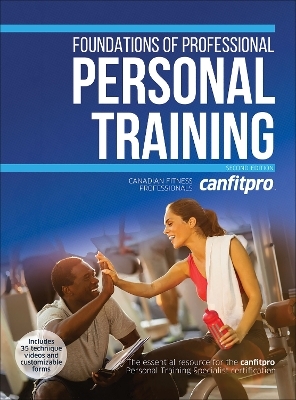
Foundations of Professional Personal Training
Human Kinetics (Verlag)
978-1-4504-6852-7 (ISBN)
- Titel erscheint in neuer Auflage
- Artikel merken
Foundations of Professional Personal Training, Second Edition With Web Resource, serves as a road map toward becoming a successful certified personal trainer. Developed and written by canfitpro, Canada’s foremost education and certification provider for fitness professionals, this full-color edition of Foundations of Professional Personal Training contains information for building skills, increasing confidence, and preparing for the Personal Training Specialist (PTS) certification with canfitpro.
Reorganized, redesigned, and extensively updated to match the canfitpro certification standards, this second edition includes colorful new artwork and all of the information needed for preparing for the PTS certification process. The second edition includes the following elements:
• A new web resource with online video to demonstrate exercise and assessment techniques
• New chapters on foundational movement sequences and dynamic assessments
• Color-coded “traffic light” elements that highlight key information for practical application by indicating when to exercise caution (red), think critically (yellow), or put a concept into practice (green)
• Three client case studies that are developed throughout the book for practice and application of concepts
• Details about canfitpro’s recommendations for optimal health, which integrates physical activity, nutrition, and mental well-being
• Strategies for cultivating the personal trainer–client relationship
• New information regarding exercise and back pain, myofascial slings and their relationship to flexibility, functional movement patterns, and postural assessment
The book is divided into four easy-to-manage parts. Part I presents an overview of the fundamentals of personal training and the personal trainer–client relationship as well as recommendations for and components of optimal health. Part II explains the essentials of the human body, including chapters on bioenergetics, the cardiorespiratory system, skeletal and muscular anatomy, flexibility and mobility, and foundational movement. Part III provides thorough guidance on both passive and dynamic assessment of clients. Part IV offers direction on program design and delivery based on client assessment as well as strategies for recognition and prevention of injury. To aid learning and prepare readers for the certification exam, each chapter includes objectives, a summary, a list of key study terms, and review questions. Readers will also benefit from a glossary, illustrated appendixes organized by muscle group and filled with information on technique for a range of resistance and flexibility exercises, and an appendix of norms for fitness assessments.
Additionally, a new web resource for Foundations of Professional Personal Training, Second Edition, provides readers with further practice opportunities before the PTS exam, featuring video clips, printable forms, and other supplemental materials. Thirty-six video clips demonstrate proper technique of various exercises as well as dynamic assessment techniques for identifying improper movement patterns or imbalance. The reproducible forms can be printed and used in assessing clients and documenting training sessions. The web resource includes answers to the in-text review questions found throughout the book, which will aid in comprehension and retention.
Foundations of Professional Personal Training, Second Edition, prepares new and prospective personal trainers for all aspects of their exciting profession. Providing key concepts, guidelines, and considerations, this text is an essential resource for preparation for the PTS exam and for a successful career in personal training.
As the leading global provider of fitness and wellness education, canfitpro empowers people to lead passionate and fulfilling lives through safe, fun, and effective physical activity. It is a division of Canadian Fitness Professionals, Inc., which was established in 1993 to provide these professionals with continuing education and professional support. In 1998, canfitpro launched its national certification program that provides one standardized, comprehensive certification body in Canada for specialists in fitness instruction, personal training, nutrition and wellness, program direction, and club management. Known for quality and positive results, a canfitpro certification establishes a benchmark for excellence and education in the fitness industry. Foundations of Professional Personal Training, Second Edition, is used by canfitpro for their Personal Training Specialist certification program for candidates who work with clients on an individual basis and design exercise programs for improved health and fitness.
Part I. The Journey Begins
Chapter 1. Understanding Yourself and Your Client
Kim Lavender, FAHP
Beginning the Personal Trainer–Client Journey
Key Qualities of Effective Personal Training Specialists
Understanding Behaviour Change
Influencing Exercise Adherence
Working With Clients
Learning Aids
Chapter 2. Principles for Optimal Health
Rod Macdonald, BEd
Kim Lavender, FAHP
Components of Optimal Health
Physical Activity for Optimal Health
canfitpro’s Recommendations for Optimal Health
canfitpro’s Training Principles
Learning Aids
Case Studies
Part I Case Study Questions
Part II. Understanding the Body
Chapter 3. Bioenergetics
Brian Justin, M.Kin
Gregory S. Anderson, PhD
Bioenergetics Terminology
Introduction to the Energy Systems
Interaction of the Energy Systems
Oxygen Deficit
Developing the Energy Systems
Learning Aids
Chapter 4. Cardiorespiratory Concepts
Gregory S. Anderson, PhD
Brian Justin, M.Kin
Cardiovascular System
Respiratory System
Cardiorespiratory Response to Exercise
Benefits of Cardiorespiratory Training
Program Design for Cardiorespiratory Training
Learning Aids
Chapter 5. Skeletal Anatomy
Gregory S. Anderson, PhD
Bones
Parts of the Skeleton
Joints
Describing Movement
Program Design for Bone Health
Learning Aids
Chapter 6. Muscular Anatomy
Gregory S. Anderson, PhD
Structure and Function of Skeletal Muscle
Muscles and Muscle Groups
Benefits of Resistance Training
Program Design for Resistance Training
Learning Aids
Chapter 7. Flexibility and Mobility Concepts
Chris Frederick, B.PT
Definition of Flexibility
Relationship of Flexibility to Overall Fitness
Mobility and Fascia
Range of Motion and Joint Mechanics
Movement, Mobilization, and Flexibility Training
Program Design for Flexibility Training
Learning Aids
Chapter 8. Foundational Movement Sequences
Mark Stone, BSc
Rod Macdonald, BEd
What Is Functional Training?
Postural Stability and Balance
Open Chain and Closed Chain Movement
Biomotor Abilities
Foundational Movement Sequences
Learning Aids
Part II Case Study Questions
Part III. Screening and Assessment
Chapter 9. Passive Screening and Assessments
Gregory S. Anderson, PhD
Chad Benson, MSc
Mark Stone, BSc
Pre-Exercise Screening
Passive Postural Assessment
Standard Health Assessment
Body Composition
Learning Aids
Chapter 10. Dynamic Assessments
Gregory S. Anderson, PhD
Brian Justin, M.Kin
Chad Benson, MSc
Dynamic Postural Assessment
Cardiorespiratory Fitness Assessment
Muscular Capacity Assessment
Flexibility Assessment
Sources of Error in Dynamic Assessments
Learning Aids
Part III Case Study Questions
Part IV. Program Design and Delivery
Chapter 11. Program Design Concepts
Rod Macdonald, BEd
Brad Schoenfeld, PhD
Principles of Program Design
Client Safety
Periodization
Selecting the Right Exercises
Structuring a Workout
Adaptability
Learning Aids
Chapter 12. Designing a Program
Rod Macdonald, BEd
Brad Schoenfeld, PhD
How to Design a Program
Applying the Four Elements of Good Program Design
Balancing the Program
Modifying Programs
Sample Program Designs
Learning Aids
Chapter 13. Delivering a Program
Rod Macdonald, BEd
Brad Schoenfeld, PhD
Five Steps of Program Delivery
Program Card
Training Session
Learning Aids
Chapter 14. Injury Recognition and Prevention Strategies
Terry Kane, BPHE, BSc
Understanding Scope of Practice
Types of Musculoskeletal Injury
Injury Prevention Strategies
Learning Aids
Chapter 15. Business of Personal Training
Mike Bates, MBA
Career Opportunities
Marketing Your Services
Selling Your Services
Maintaining and Building Your Clientele
Your Professional Image
Client–Trainer Relationship
Terminating the Relationship
Risk Management
Policies and Procedures
Learning Aids
Part IV Case Study Questions
| Verlagsort | Champaign, IL |
|---|---|
| Sprache | englisch |
| Maße | 216 x 279 mm |
| Gewicht | 1542 g |
| Themenwelt | Sachbuch/Ratgeber ► Gesundheit / Leben / Psychologie |
| Sachbuch/Ratgeber ► Sport ► Fitness / Aerobic / Bodybuilding | |
| ISBN-10 | 1-4504-6852-7 / 1450468527 |
| ISBN-13 | 978-1-4504-6852-7 / 9781450468527 |
| Zustand | Neuware |
| Haben Sie eine Frage zum Produkt? |
aus dem Bereich



